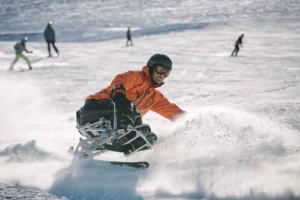Mike’s Story
Hey, my name is Mike Brown. I am a paraplegic from New Zealand. About 12 years ago I was hit by a car and subsequently broke my back at T10. Before my injury, I was an engineer and I spent a lot of time outdoors, be it sailing, climbing, fishing, skiing or mountain biking. They gave me my fitness, not only in my physical fitness but my mental fitness and well-being. And, when I broke my back, I continued and discovered that several adaptive sports could also provide that same physical and mental well-being and that was also fun. In recent years I’ve been incredibly busy. I am the co-founder of a startup called Adaptdefy and we create products for wheelchair users. Being a startup founder is incredibly challenging, and takes a lot of time.



With my fitness, I’m looking for optimal health and I’m looking for longevity. As a wheelchair user, there are a lot of things that are stacked against you so I’m trying to be physically and mentally prepared to get as much as I can out of this wheelchair life. So with that, my fitness is really important and more so as we age, I’m 45, so I’m mindful of wanting to live a long and healthy life.
“The biggest challenge for me when incorporating fitness activity was finding time and creating a habit of doing it.”
The biggest challenge for me when incorporating fitness activity was finding time and creating a habit of doing it. An awesome book that helped me is called Atomic Habits because It breaks down what a habit is, how to create good habits and how to break bad habits. And the main thing for me was making opportunities for fitness easier. Going to the gym had to be on route to the office or somewhere close to home and also I needed to create accountability. For me, that’s going to the gym with my son who enjoys a workout. So he’s a good accountability partner and it’s something we enjoy together.
My day always starts with breathwork, I’ve found a short 10-minute breathwork session. It feels really good and I think it grounds my day. I’ve combined that with a cold plunge with a thermostat to control the temperature which I set to about two degrees centigrade which I do for about four minutes. I feel super energised afterwards and there are lots of health benefits that are well documented. I also added sauna time to this and stretching, especially lying on my front helps to counter sitting all day.
Every night I do resistance band exercises with my rotator cuffs. The way I make that habit stick is to have the bands by my bedside table. I do it before I jump into bed. Because I see at the end of the day, it’s a visual reminder to do it. I go to the gym once a week. I’d like to go more but I always go to the gym once a week with my son. The focus of that gym I’m doing exercises to counteract those overworked and overdeveloped muscles from being a wheelchair user with the idea of shoulder balance.
“What I like about Adapt to Perform content is that you don’t need expensive equipment. You could use a broom handle, and it’s very wheelchair-centric, so it’s pretty awesome.”
I’ve noticed a remarkable improvement in both my energy levels and mental well-being since incorporating regular exercise into my routine. Additionally, being mindful of my nutrition and abstaining from alcohol for over a year has had a positive impact. Prioritising eight hours of sleep each night has also played a significant role. The collective effect of these lifestyle changes has been powerful, not only physically but also in understanding and managing my emotional reactions. It’s amazing how waking up well-rested, nourishing your body with good food, and engaging in regular exercise can synergistically contribute to a profound overall impact on one’s well-being.
What I like about Adapt to Perform content is that you don’t need expensive equipment. You could use a broom handle for instance and it’s very wheelchair centric so it’s pretty awesome. I did employ a personal trainer in the past but I found that they weren’t that familiar with wheelchair users so I wasn’t sure that the sessions were that effective. So having a resource like Adapt to Perform that’s targeted to wheelchair users is awesome.
I wanted to give you some advice and maybe I’ve already given this, I would say, learn about how habits are formed. Find a way to stack multiple habits and put the odds in your favour. Find and be part of a community that is into health and fitness and they can become your accountability coaches and can encourage you to stick with it even if it’s online or in person it can help.
The benefits of my health and fitness routine may not always be immediately apparent, as they unfold gradually over time. However, I’ve noticed tangible improvements in my daily life—I can effortlessly transfer and manoeuvre my wheelchair, and pull myself in and out of the car with ease. As I age, maintaining this ability is crucial, and it motivates me to focus on building shoulder strength and stabilising muscles.
“I’ve noticed a remarkable improvement in both my energy levels and mental well-being since incorporating regular exercise into my routine.“
During activities like sit skiing, the impact of my efforts becomes even more apparent. Engaging in tricep exercises at the gym translated into a noticeable increase in strength, making the physical demands of skiing more manageable. These small victories accumulate and create a meaningful impact, especially when viewed over an extended period.
For anyone contemplating a health and fitness journey, my advice is simple: take that first step. Whether it’s starting with small exercises or finding a supportive group, initiating the process is key. Over time, these efforts can lead to substantial improvements in both physical and mental well-being. So, find your starting point and commit to the journey ahead.